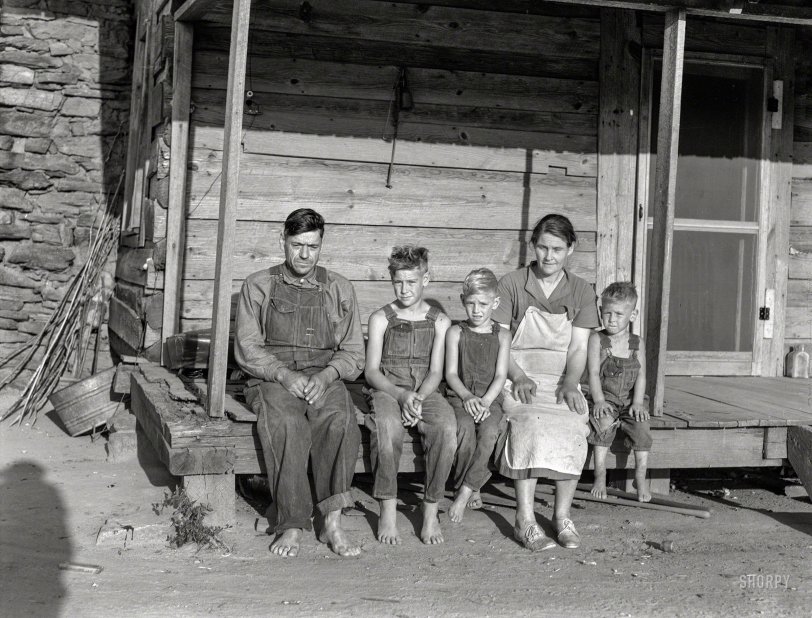


Framed or unframed, desk size to sofa size, printed by us in Arizona and Alabama since 2007. Explore now.
Shorpy is funded by you. Patreon contributors get an ad-free experience.
Learn more.

- Freeze Frame
- Texas Flyer wanted
- Just a Year Too Soon
- WWII -- Replacing men with women at the railroad crossing.
- Yes, Icing
- You kids drive me nuts!
- NOT An Easy Job
- I wonder
- Just add window boxes
- Icing Platform?
- Indiana Harbor Belt abides
- Freezing haze
- Corrections (for those who care)
- C&NW at Nelson
- Fallen Flags
- A dangerous job made worse
- Water Stop
- Passenger trains have right of way over freights?
- Coal
- Never ceases to amaze me.
- Still chuggin' (in model form)
- Great shot
- Westerly Breeze
- For the men, a trapeze
- Tickled
- Sense of loneliness ...
- 2 cents
- Charm City
- What an Outrage
- Brighton Park
Print Emporium
Green Acres: 1937

July 1937. "White sharecropper family, formerly workers in the Gastonia textile mills. When the mills closed down seven years ago, they came to this farm near Hartwell, Georgia." Medium format negative by Dorothea Lange. View full size.
Poor Pride
My family hails from Gaston County, where the above mentioned Gastonia - in spite of sounding like an intestinal ailment - is actually the county seat. Many of my family worked, at least briefly, in one or more of the mills that abounded in Gaston County, and gained international attention in 1929 due to the Loray Mill strike.
There is a good-natured competition among some in the area where they try to outdo one another as to who was the poorest. My stepfather, in my opinion, holds that “honor” with his haircut story. While some claim they were so poor that there mother would put a bowl on their head and then trim around it with scissors, my stepfather claims they were too poor to even own a pair of scissors. This meant they could only get haircuts in the winter, when they would wash their hair in ice-cold well water and then sit on the back porch until their hair had frozen solid. At this point his mother would place a bowl on their had and break off the now brittle hair against the bowl. He claims to have not even known any other method of hair cutting existed until he entered the Marines at age 18.
I'm amazed
that in each of the Depression/Dust Bowl pictures that we see, the family, no matter how poor, always seems to have the children's hair trimmed and cut. Don't know how they did that.
[By Mom or Dad with a scissors, and sometimes a bowl. -tterrace]
August, I think
I'm guessing it's not penury, but August. Notice that the only clothing with holes is the little boy on the right. They don't have a ton, but they bought new overalls that spring for all but the little one.
Update: regarding Naveeks' question about the haircuts, scissors have been around for a long time, and Wahl made their first home haircutting kits in 1919. Also, the culture at the time was that men got their hair cut even if they were poor--barbers have told me that their profession was one of few that did OK during the depression. Two bits per shave and a haircut for men put food on barbers' tables, really.
Barefoot family
It's not unusual to see barefoot kids in these photos, but it's sad that even the Dad couldn't come up with a pair of shoes to have his picture taken. Both parents look prematurely aged. One can only hope that the economic boom created by WWII brought them some factory work that lifted them up economically.
Collateral Damage
I've yet to see a single photograph of a Depression era migrant family that doesn't evoke in me poignancy and sadness. Only an assumption by me, of course, but I'd be willing to bet the Salt Of The Earth wife and mother pictured here will live out the rest of her days with only three fingers on her right hand due to the horrific and dangerous working conditions she encountered in the textile mills of that time period, all in the pursuit of an (un)livable wage for her family.
Future
Seems to be a hard working family.
Wonder if Dad ended up with a war job; did life for the family improve in 1941/1942?
Oldest boy might have been a bit young for WWII, but he might have made Korea. The other two might also have made Korea.
Not Much Nostalgia Here
We moderns tend to forget just how poor so many people were during the Great Depression. We fixate on the "Improved Lincoln Logs" that fit so neatly on the building's façade, without noting the family's generally ragged and worn-out condition. The men/boys are barefoot, the wife/mother's shoes look like they are about worn out, and even one of the boys has a lined face -- probably a solar overdose in that age before sunscreen.
And these are an "intact" family -- not one that has broken up from the stresses imparted by poverty or suffered the death of one of the adults. They're working the land not because their ancestors did so but because their factory work evaporated. Tough times indeed.
Mom
Mom lost a finger somewhere along the line. My money would be back at the cotton mill.
Not much Green there a single weed
By the look of that family. Appears to be desperate times.
Women had(/ve) it harder
Assuming that Mr. and Mrs. Croppy are roughly the same age, or he is a bit older (as was the norm then), she aged even worse than her husband.
Good old times? Thanks, but no thanks.
























On Shorpy:
Today’s Top 5